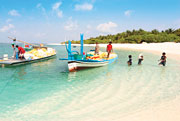| Whale Shark Mating Area is Leased for Developing into Industrial Site |
 |
| Hanifaru in Baa Atoll, is an uninhabited island with a natural underwater bay -locally known as ‘Vandhumaafaru Adi’ famous for whale sharks. The bay, known to... read more |
| |
| Sand Mining Might Erase Some Islands from Map of Maldives |
 |
| Since time immemorial artisanal coral sand extraction or mining from local beaches and lagoons, mainly for construction... read more |
| |
| Towards an Artificial Paradise on Earth |
 |
| The Government has recently announced plans to develop ten artificial islands by reclaiming natural lagoons of inhabited islands... read more |
| |
|
